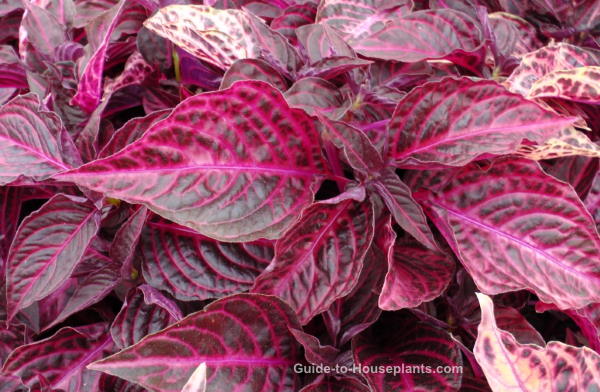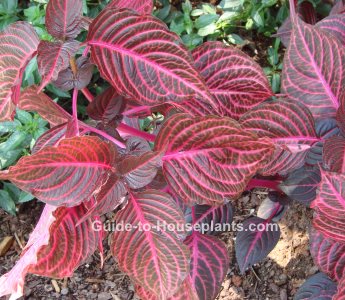Iresine herbstii
Botanical Name: Iresine herbstii
Bright red leaves with prominent red veins are the attraction of this Brazilian plant. Luckily for us, this tropical native happens to adapt well to being indoors, making it a spectacular room accent.
 You can see why Iresine gets the common names bloodleaf plant and beefsteak plant.
You can see why Iresine gets the common names bloodleaf plant and beefsteak plant.Many varieties have lance-shaped leaves (as shown here) but some are more rounded. The leaves grow 3-6 inches (8-16 cm) long, in opposite pairs.
Small, greenish-white flowers may appear in summer. You can pinch them off, if you want, because they aren't nearly as stunning as the brilliant foliage.
Year-Round Care
This tropical native needs warmth, humidity and plenty of light to thrive. Put it near a window or in a sunroom to maintain its vibrant color. If you set it on your porch or patio for the summer, keep it shaded from hot, direct sunlight.
Repot in spring. When you see roots growing out of the drainage holes, it is time to repot. Move it up to a container just 1-2 inches larger, using a pot with drainage holes to prevent soggy soil. If you want to use a container without drainage holes, use it as a cachepot. Just slip a plain nursery pot into the cachepot. I put pebbles in the bottom of cachepots to keep the inner pot above the drainage water. As the water evaporates, it adds humidity around the plant -- and this tropical native will love it.
Prune it back. Spring is the best time to prune this shrubby perennial. It's fast-growing and responds well to pruning. As older leaves fall off, it will become leggy as it grows. Cut off soft stem tips to keep Iresine herbstii compact. Don't toss out those cuttings, either. Pot them up to grow more plants (see "Propagation" below).
Watch for aphids. These tiny pests are attracted to the soft, new growth on plants. Aphids feed by sucking sap from a plant, weakening it and causing distorted foliage. Treat any infestation immediately.
Iresine Herbstii Varieties
This vibrant foliage plant is commonly known as Blood Leaf, Beefsteak and sometimes Chicken Gizzard. Popular cultivars include 'Aureoreticulata' which has green leaves with yellow veins and red stems, and 'Brilliantissima' with bright-pink veins.
Iresine Herbstii Care Tips

Origin: Brazil
Height: Up to 2 ft (60 cm) when grown in a pot indoors
Light: Bright light is necessary to prevent the bright leaf color from fading. Shade the plant from hot, direct summer sun. It thrives under indoor grow lights. Leggy plants aren't getting enough light.
Water: Water thoroughly, aiming to keep the potting mix lightly moist at all times. Empty drainage tray to prevent soggy soil, which can lead to root rot. Water less in winter, when growth has slowed. Older plants are drought-tolerant.
Humidity: Try to maintain 50% relative humidity or higher. Use a humidity tray or room humidifier to raise the moisture in the air around it.
Temperature: Average to warm room temperatures 65-80°F/18-27°C. Don't expose Iresine to temps below 55°F/13°C. This tender perennial prefers to stay warm, like we do.
Soil: Any good-quality, all-purpose potting mix.
Fertilizer: Feed every 2 weeks spring through fall with a balanced water-soluble fertilizer. Don't feed in winter when growth is slower.
Propagation: Take 3-4 in (8-10 cm) soft stem tip cuttings in early spring and root them in moist perlite. They root easily.


